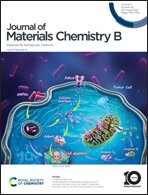NiCo LDH nanozymes with selective antibacterial activity against Gram-negative bacteria for wound healing†
Abstract
Bacterial infections have been a major threat to human health. Especially, Gram-negative (G−) bacterial infections have been an increasing problem worldwide. The overuse of antibiotics leads to an emergence of drug resistance, and thus the development of novel antimicrobial agents is important, particularly against G− bacteria. Nanozymes use reactive oxygen species (ROS) to kill bacteria, reducing the risk of bacterial resistance and providing new opportunities to meet the challenges of strain selectivity. Here, we synthesized NiCo layered double hydroxide (LDH) nanozymes, which exhibit selective antibacterial activity based on their peroxide-like (POD-like) activity. To obtain the highest antibacterial activity, the POD-like activity of NiCo LDH nanozyme was further optimized by tuning the ratio of nickel and cobalt, and Ni4Co6 LDHs showed the highest POD activity and antibacterial activity. More importantly, Ni4Co6 LDHs can achieve selective sterilization of G− bacteria due to their electrostatic adsorption and hydrophilic interactions with the bacterial cell wall. Animal experiments further indicated that the healing of G− bacteria-infected wounds was effectively promoted without damaging their normal biological tissues. In conclusion, we provide a selective antibacterial agent through a simple strategy, which provides a new direction for the application of nanozymes.

- This article is part of the themed collection: Nanozymes


 Please wait while we load your content...
Please wait while we load your content...